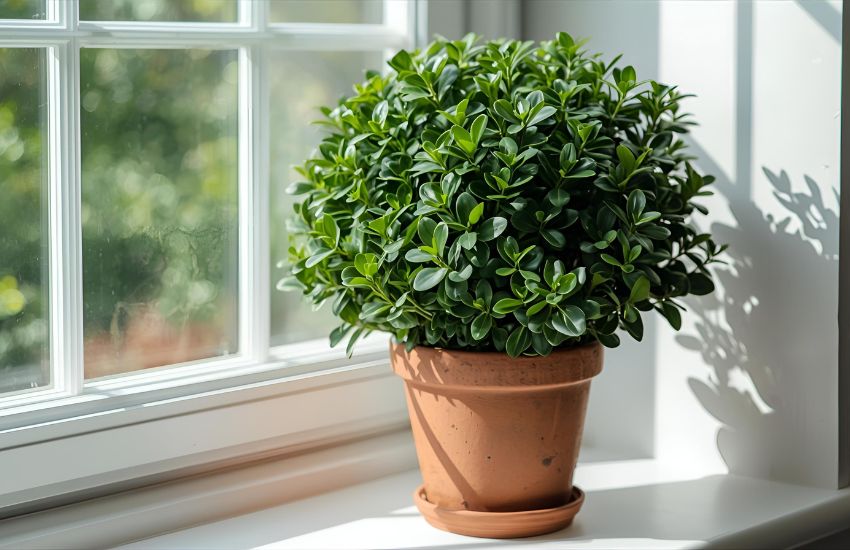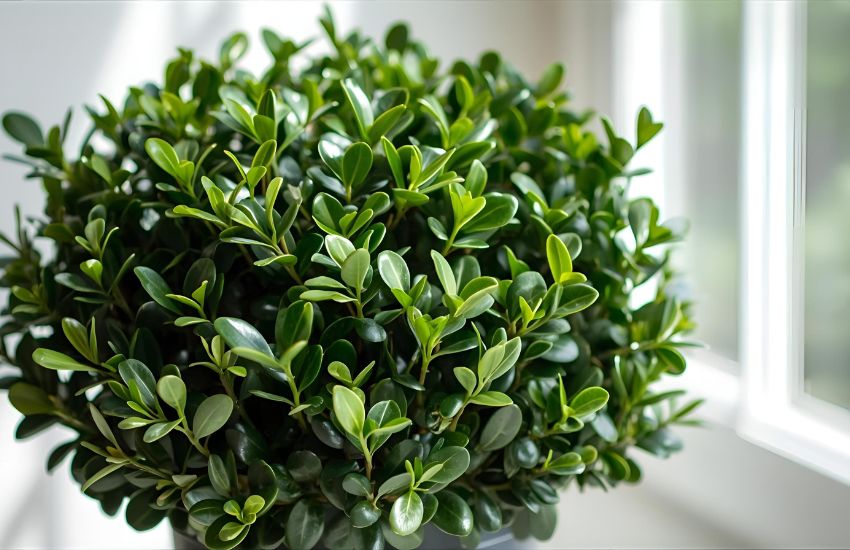Whether you’re aiming to bring refined elegance into your living space or seeking a low maintenance plant with architectural charm, the boxwood buxus plant offers a timeless indoor solution. Known for its dense, glossy green foliage, this evergreen shrub thrives in containers and adapts well to shaping—making it ideal for topiary, formal hedges, or structured formal gardens. Its slow new growth, broadleaf structure, and deer resistant nature make it a favorite among discerning indoor gardeners.
Boxwood Buxus plants, including elegant varieties like Common Boxwood, thrive indoors with bright, indirect light, moderate humidity, and well-draining soil. Water when the top inch is dry and trim regularly to maintain shape. Avoid overwatering to prevent root rot. These classic evergreen shrubs add year-round beauty and structure to your indoor space.
In this care guide, you’ll discover practical tips on lighting, watering, selecting the right cultivar, managing pests, and encouraging healthy foliage. Learn how to master prune techniques, sculpt captivating topiary, and support your boxwoods in full sun or indoor-friendly conditions. Let’s shape your indoor space with purpose and evergreen beauty.
Prevent Pest Issues in Buxus Microphylla Var Based on Hardiness Zone

Understanding the relationship between pests and the climate of your region is essential when growing Buxus Microphylla Var—one of the most reliable boxwood shrubs for both structure and elegance. Whether you are cultivating korean boxwood, american boxwood, or the dwarf cultivars like ‘Compacta’, your approach to pest prevention should be tailored to your USDA hardiness zone. Here’s how you can protect these iconic shrubs across various climates while preserving their green leaves and formal appeal.
Know Your Hardiness Zone to Tailor Pest Management
The hardiness zone determines your plant’s ability to withstand climate extremes and also influences which pests are most prevalent. For instance, in warmer zones (7–9), boxwood psyllid and leaf miners are frequent nuisances, while in cooler zones (5–6), fungal issues due to damp conditions are more likely. You must adjust your care practices—including watering, airflow, and pruning in late winter or early spring—based on these zone-specific risks.
Regular Monitoring for Early Detection
Routine inspection is the most effective defense against pest outbreaks in buxus microphylla var and its relatives like buxus sinica. Check your boxwood or box tree for signs such as yellowing foliage, distorted tips, or sticky residue. Early detection of boxwood psyllid or mites can prevent full-blown infestations and reduce the need for chemical treatment.
Choose Pest-Resistant Varieties for Your Zone
For gardeners in humid climates, selecting cultivars like ‘Green Mountain’, a hardy hybrid known for its dense green foliage, can reduce the likelihood of disease and pest stress. Similarly, dwarf forms such as Buxus Microphylla Var. ‘Compacta’ are less prone to infestations due to their tight growth habits, making them ideal for use in formal hedges or containers where space and control are priorities.
Promote Airflow and Healthy Growth
Proper spacing between plants is vital in every zone to improve air circulation and discourage fungal growth. When establishing a box tree, avoid overplanting. This not only reduces the risk of disease but also deters pests that thrive in moist, overcrowded environments. Encourage dense but healthy foliage through responsible pruning and soil management.
Apply Preventive Measures Responsibly
If your zone is known for persistent pests, consider using neem oil or insecticidal soap in early spring as a preventive treatment. Apply these with care, especially on american boxwood or korean boxwood, which may be sensitive to certain chemical residues. Always test a small area before full application.
Know the Botanical and Common Names to Shop Smart
Whether you refer to it by its latin name for boxwood, such as Buxus Microphylla Var. or simply by the name for boxwood or box, understanding the correct terminology will help you purchase pest-resistant cultivars suited to your zone. Nurseries often label pest-resistant strains specifically for regional adaptation.
Boxwood Buxus Plant Detail: Care Tips for Buxus Sempervirens Indoors

- Buxus sempervirens, also known as boxwood, is one of the oldest known garden plants, prized for its classic form and versatility in both indoor and outdoor environments.
- Indoors, it grows well as a broadleaf evergreen shrub or can be shaped into a shrub or small tree, offering year-round structure and greenery to your living space.
- Choose compact boxwood varieties like ‘Suffruticosa’ or ‘Green Velvet’ that adapt well to container living and typically stay under three feet wide.
- Place your boxwood near the edge of a bright window where it will receive bright, indirect sunlight. Avoid direct sun that may scorch the foliage.
- Use well-draining soil in a pot with drainage holes to prevent root rot. Water only when the top inch of soil is dry to the touch.
- Prune lightly during the growing season to maintain shape and encourage dense growth. Avoid heavy pruning during winter when growth is minimal.
- Boxwood is susceptible to boxwood blight, a fungal disease that causes leaf drop and black stems. Ensure good airflow and avoid overhead watering to reduce risk.
- Watch for the boxwood leaf miner, a common pest that causes blistered, discolored leaves. Inspect regularly and isolate affected plants promptly.
- Keep your boxwood away from other shrubs and conifers if pest or disease issues arise, as they may spread across plant types.
- Position it as a decorative accent near walls, room edges, or entryways where its structured look adds refinement to the space.
- With proper care, indoor boxwood remains a reliable, ornamental, and evergreen addition to your home—balancing beauty with botanical tradition.
Conclusion
With its dense growth habit, deep green foliage, and ability to thrive in partial or dappled shade, the Buxus sempervirens—much like its relatives such as japonica and inkberry—continues to be a highly versatile and sophisticated choice for indoor and formal landscapes. These small to medium-sized evergreens, dating back to 4000 BC, have stood the test of time, bringing structure, greenery, and order to indoor and outdoor spaces alike.
Thanks to its adaptability to a variety of soil types (as long as they are not poorly drained) and tolerance to different sizes and shapes, boxwood makes an excellent shrub for hedges, low hedging, or standalone features in borders and foundation plantings. Its habit and evergreen nature ensure year-round beauty, and being deer-resistant, it also suits areas vulnerable to browsing wildlife.
When left unpruned, boxwood maintains a softer, more natural look; however, to preserve its clean shape and encourage strong growth, it’s best to prune in late spring. Protect the plant from winter wind and common plant problems like fungal diseases, and your boxwood will reward you with enduring color and form.
Whether you’re designing a structured indoor corner, adding texture to a minimalist room, or bringing depth with its rich green color, boxwood embodies timeless elegance and refined simplicity.
Ready to elevate your indoor space with the charm of boxwood? Choose a healthy, compact cultivar and enjoy the unmatched beauty and structure of this classic, versatile shrub—perfectly suitable for USDA indoor settings. Begin your journey toward structured green living today.
Frequently Asked Questions (Boxwood Buxus Plant Care Guide for Elegant Shrubs Like Common Boxwood Indoors)
Can boxwood (Buxus) be grown successfully indoors?
Yes, boxwoods can adapt to indoor environments if given proper care. They prefer bright, indirect light and good airflow. Place them near a sunny window but protect from direct scorching rays. Indoors, maintaining consistent temperatures and avoiding dry air from heaters is essential for their health.
How often should I water my indoor boxwood plant?
Water boxwoods when the top inch of soil feels dry. They like evenly moist soil but should never sit in standing water, as this causes root rot. Reduce watering slightly in winter when growth slows, but never let the plant completely dry out.
What kind of soil and container are best for indoor boxwood?
Boxwoods thrive in well-draining, loamy soil with a neutral to slightly alkaline pH. A container with proper drainage holes is crucial to prevent waterlogging. Adding a layer of pebbles at the bottom of the pot can improve airflow around the roots.
How do I keep my indoor boxwood looking elegant and healthy?
Prune lightly to maintain its shape and encourage dense growth. Regular misting or using a humidity tray prevents leaf browning in dry indoor air. Fertilize every 4–6 weeks during the growing season with a balanced, slow-release fertilizer to keep foliage lush and green.
